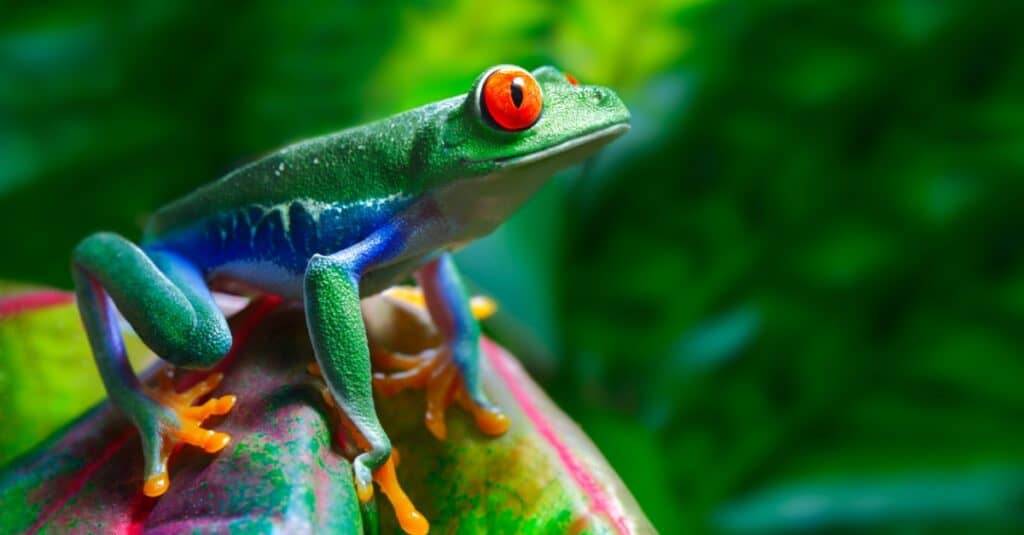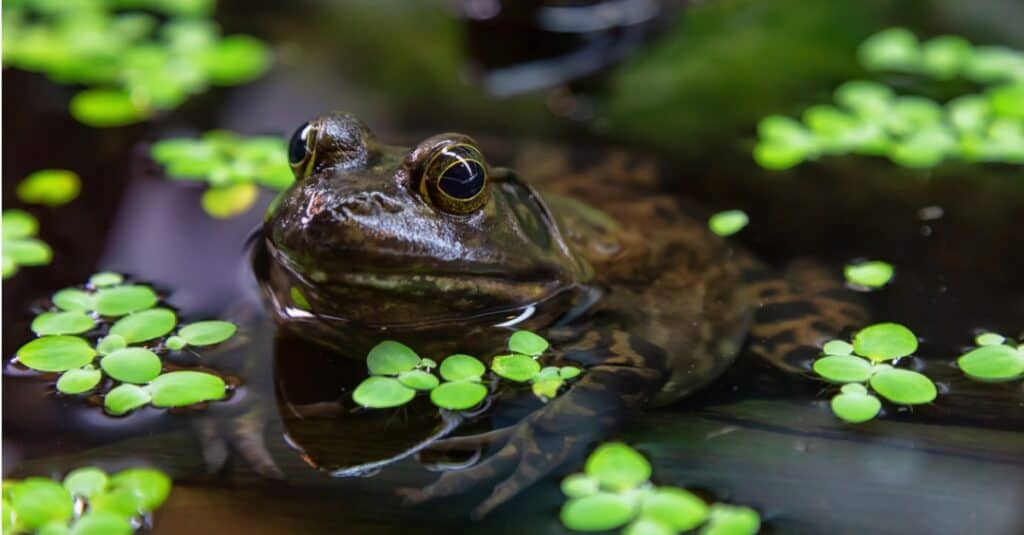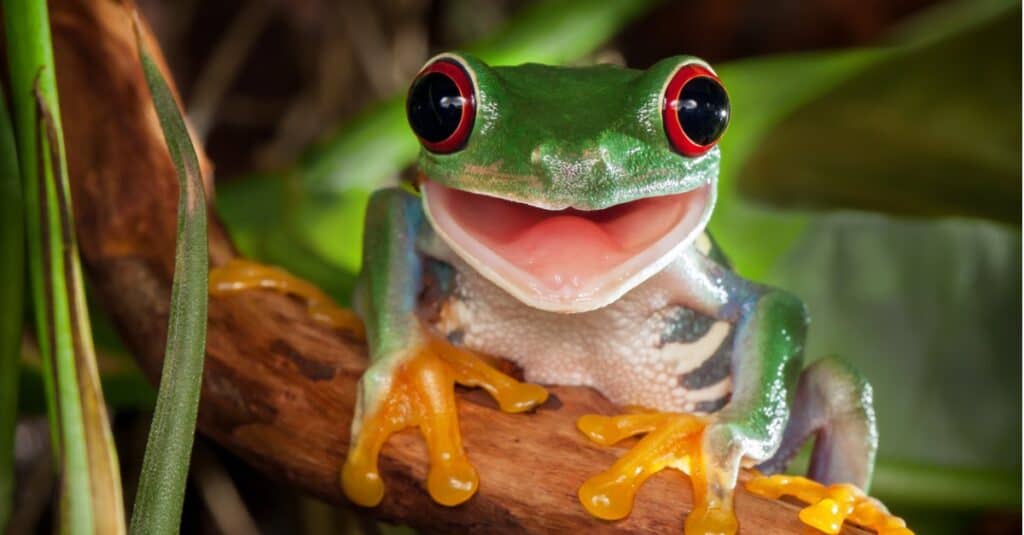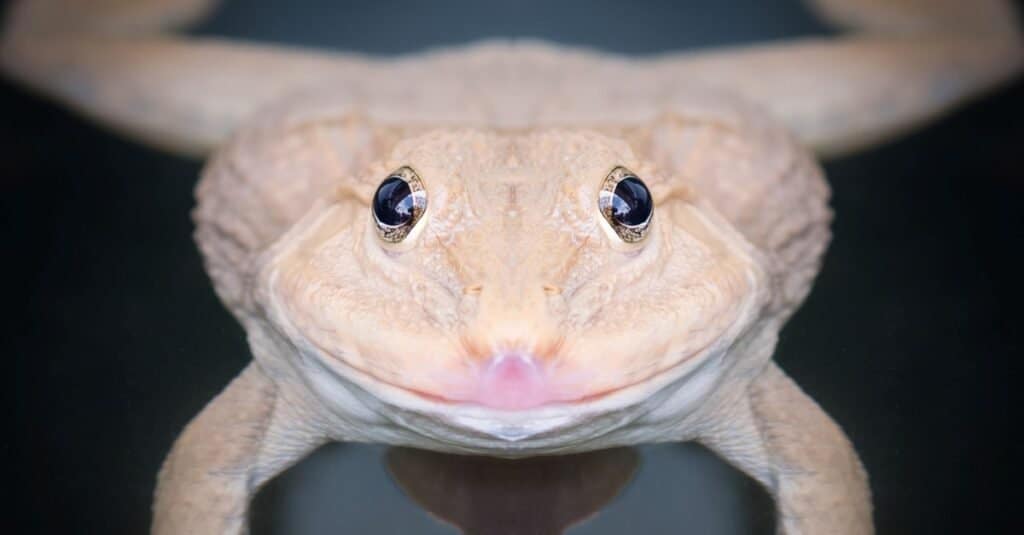If you’ve recently adopted a pet frog or are planning on taking one in and aren’t sure how to care for it yet, you probably have all kinds of questions about their needs in captivity. From figuring out your frog’s species to their ideal habitat to what kind of food they eat, this guide will cover everything you need to know so your new pet can live their best life.
Read on to learn more about frogs as pets and what their many care requirements entail! You might be surprised to learn just how specific and detailed most frogs’ care needs really are.
Determine Your Frog’s Species

Red-eyed
tree frogs
are popular pets thanks to their unique appearance.
©Brandon Alms/Shutterstock.com
Finding out what species your frog is should be your first step in providing them with quality care. Incredibly, there are over 5,000 documented species of frogs that all have their own unique needs both in the wild and in captivity!
From temperature to enclosure size to humidity and water levels, a tomato frog is going to require a very different setup from, say, a Budgett’s frog and so on. Some frogs are entirely aquatic, while others are semi-aquatic and require both land and water to thrive. Some frogs are omnivores, while others are purely carnivorous.
If you purchased your frog from a breeder or a pet shop, you may already know their species. You can always reach out to where you purchased the frog for more information. However, if you adopted them from a friend or a neighbor or they’re a rescue, this may be more complicated.
I still highly recommend contacting a breeder or exotic vet if your frog is a rescue, though! Most experienced amphibian/reptile breeders and veterinarians are able to easily identify certain species thanks to the knowledge they’ve accumulated throughout their careers. If possible, attend a reptile and amphibian expo and get a few opinions to be sure. If there are no expos in your area, politely contacting a well-known breeder with pictures of your frog may still get you a quick response.
Some of the most common frogs kept as pets include:
- White’s tree frogs
- Amazon milk frogs
- Fire-bellied toads (technically still frogs!)
- Pacman frogs
- African bullfrogs (AKA Pixie frogs)
- Budgett’s frogs
- Red-eyed tree frogs
- Tomato frogs
- American green tree frogs
- American toads (also technically frogs!)
Buy a Suitable Enclosure For Your Frog

Most pet frogs need at least some water in their enclosures to swim and soak in.
©iStock.com/edb3_16
All frogs need some kind of enclosure for housing, regardless of their size, species, etc. Most smaller species of frogs thrive in 20 to 50-gallon enclosures. Larger species may need 100 gallons or more to feel comfortable. The size and setup of your enclosure will largely depend on your frog’s species.
There are a few key reasons why an enclosure is so important, most of which involve your frog’s safety. If possible, buy and set up an enclosure before you bring your frog home!
For starters, like reptiles, amphibians such as frogs are ectotherms, so they rely on their environment to stay warm. While your frog may be just fine in their native habitat, they require very specific conditions to thrive in your home. Maintaining these conditions in an enclosure is much easier than adapting your entire home to suit your frog’s needs. You may need basking bulbs, water heaters, under-tank heaters, or even ceramic heat emitters to keep the enclosure warm.
Additionally, most frogs need at least some water or very moist conditions to thrive. Depending on whether they are fully aquatic or semi-aquatic, your frog will need anywhere from an inch or two of water to a few feet of water to swim in. A sealed, durable enclosure will make it easy to add water to your frog’s environment. Most species also require a water filter to keep the water clean and fresh.
Perhaps the most obvious reason why enclosures are necessary in captivity is to keep your pet frog safe under your care. You definitely don’t want to allow your frog to have free roam of your home and end up eating something they aren’t supposed to or, worse, getting lost, stepped on, or escaping your home altogether.
Setting Up Your Frog’s Enclosure

Many semi-aquatic frogs like having branches, rocks, and other platforms to climb on.
©iStock.com/Linas Toleikis
Once you have a suitable enclosure for your frog, you’ll have to furnish it to suit their species’ needs. All frogs have to live in at least some water to thrive, but again, the exact amount will depend on whether your frog is semi-aquatic or fully aquatic. Other important factors to keep in mind are ideal temperature and humidity levels, substrate, and decorations for enrichment. Many aquatic and some semi-aquatic species that need lots of water to swim in also need water filters to keep their enclosures clean.
Once you know your pet frog’s species, research the air and water temperatures they thrive in to care for them properly. The humidity level they need in captivity is also important. Pet shops and many online retailers sell temperature and humidity gauges designed for reptile and amphibian habitats.
From there, you can achieve the ideal temperature by using heat/basking lamps, ceramic heat emitters, or even under-tank heaters for certain species. These heat sources and the fixtures designed to house them are also sold at most pet shops. Many species of frogs also require UVB lighting to keep their bones and muscles strong. Humidity is a bit easier to adjust, either by misting with a water bottle or increasing the enclosure’s water level.
The ideal substrate will also vary depending on your frog’s species. Substrate is the material you’ll use to cover the floor of the enclosure. For aquatic frogs, large river rocks or gravel can work well. Semi-aquatic or arboreal frogs that don’t swim as much may require something that retains moisture well, like moss, soil, or coconut fiber.
Finally, decorations like hides, rocks, and plants also provide enrichment depending on your frog’s species. Some frogs prefer having lots of open water to explore, while others like clutter for privacy.
Learn About Your Frog’s Dietary Needs

Frogs are almost exclusively carnivorous and enjoy eating insects.
©iStock.com/Antagain
Once you’ve set up your frog’s enclosure, you should learn about their dietary requirements. Virtually all frog species are carnivorous. However, some frogs are temporary herbivores while they are very young! Different species have different diets, so knowing your frog’s species is especially important here.
Most carnivorous frogs enjoy eating a mixture of feeder insects, arthropods, and even small fish. More specifically, some ideal food sources for most frogs include:
- Mealworms and superworms
- Earthworms
- Crickets
- Waxworms
- Brine shrimp
- Minnows and other small fish
- Roaches (Dubia and discoid roaches recommended)
- Snails, slugs, and other molluscs
- Mice* (only for certain large species of frogs)
In the wild, frogs will occasionally even eat lizards, other frogs, turtles, and rodents. However, this behavior is rare and only occurs when their usual food sources are scarce. Only certain large species like Pacman frogs and bullfrogs are able to eat pinky mice safely.
As a general rule of thumb, keep any prey smaller than the width of the space between your frog’s eyes. This will reduce the risk of choking, digestive impaction, and constipation. Observe your frog while they eat in case they struggle.
If your frog is very young or perhaps even still a tadpole, they may also eat a small amount of plant matter. Dark, leafy greens and most other vegetables are ideal for very young frogs and tadpoles.
A calcium supplement is also recommended for most frog species. Calcium supplements for reptiles and amphibians are typically sold in powdered formulations. Simply sprinkle a small amount of the calcium powder onto each of your frog’s meals.
Find a Qualified Reptile/Amphibian Vet

A yearly vet check-up is an essential part of your pet frog’s care.
©tratong/Shutterstock.com
Once you’ve set up your frog’s enclosure and understand their dietary needs, find a local reptile/amphibian veterinarian ASAP. It’s a good idea to take your pet frog to see a vet within their first month or two in your care. Additionally, a yearly check-up with a qualified veterinarian will help you stay on top of your frog’s medical needs.
Many beginner amphibian and reptile owners mistakenly believe that these animals don’t necessarily need to see a vet in order to thrive like dogs or cats do. However, the reality is the exact opposite!
First, amphibians and reptiles tend to not display signs of illness or injury unless they are near death. This is actually a self-defense mechanism to prevent themselves from looking weak to nearby predators. While a dog or a cat or even a bird might clearly display their distress, frogs are much more discreet. You’ll usually need a veterinarian to conduct certain tests to pinpoint your frog’s cause of illness or injury.
Additionally, prompt treatment is essential in ensuring your frog lives a long, happy life under your care. If your frog has gotten to the point where their symptoms are very obvious, they may end up suffering long-term side effects even if you get them to a vet as soon as you notice their symptoms. However, if your veterinarian is able to detect a certain illness or injury via an exam or testing before it becomes very obvious, they can treat your pet much more quickly and effectively.
Some common illnesses in frogs include:
- Metabolic bone disease (also known as MBD)
- Bacterial and fungal infections
- Internal and external parasites
- Impaction
- “Toxic out” syndrome
- Dehydration
The photo featured at the top of this post is © iStock.com/Linas Toleikis
Thank you for reading! Have some feedback for us? Contact the AZ Animals editorial team.






